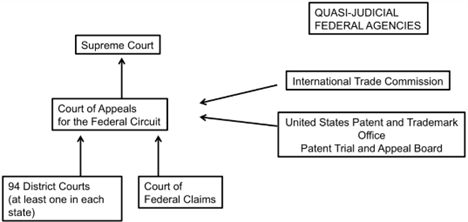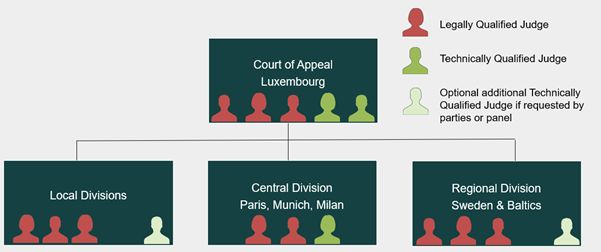Patent litigation in Germany is mainly governed by the Patent Act, which includes provisions on:
- patentability, prosecution and opposition procedures before the German Patent and Trademark Office;
- nullity and compulsory licence proceedings before the Federal Patent Court; and
- infringement, based on which patents may be asserted before the German civil courts. Proceedings before the civil courts are governed by the Code on Civil Procedure.
Employee inventions are governed by the Act on Employee Inventions.
The protection of utility models is regulated by the Utility Model Act.
The Unified Patent Court (UPC) system – including the European patent with unitary effect (‘unitary patent’) – is governed by:
- the Agreement on a UPC, accompanied by:
-
- the Rules of Procedure of the UPC, which set out the details of litigation; and
- the Table of Court Fees;
- EU Regulation 1257/2012/EU establishing the unitary patent; and
- EU Regulation 1260/2012/EU establishing the translational arrangements for the unitary patent.
Patents in the United States are governed by the Patent Act Title 35, which established the US Patent and Trademark Office (USPTO). The Federal Rules of Civil Procedure generally govern the procedures related to patent litigations in the United States. Each federal district court may also have its own local rules governing actions before the court. With respect to evidentiary rules, the Federal Rules of Evidence govern the admission and use of evidence. For post-grant patentability challenges conducted at the USPTO, the America Invents Act established the Patent Trial and Appeal Board (PTAB). The PTAB is a tribunal that hears and adjudicates challenges of issued patents in post-grant reviews and inter partes reviews. The PTAB has its own set of rules and regulations that govern the proceedings in that venue.
IP law in Germany is strongly influenced by the legislation of the European Union. This includes:
- regulations which are immediately effective in EU member states; and
- directives which require formal implementation into national law.
This has resulted in a noticeable degree of harmonisation across the EU member states. Relevant EU legislation includes, for example:
- the Enforcement Directive (2004/48/EC);
- the Regulation on the Customs Enforcement of Intellectual Property Rights (608/2013);
- the Regulation on Jurisdiction and the Recognition and Enforcement of Judgments in Civil and Commercial Matters (1215/2012, amended by Regulation 542/2014);
- the Unitary Patent Regulation (1257/2012);
- the Unitary Patent Translation Arrangements Regulation (1260/2012); and
- the Regulation Concerning the Supplementary Protection Certificate for Medicinal Products (469/2009).
Germany is also a party to the following international treaties relevant to patents:
- the Paris Convention for the Protection of Industrial Property 1883, governing the right of priority, among other things;
- the Patent Cooperation Treaty, regulating a common international patent application procedure;
- the Act Revising the European Patent Convention 2000, on a uniform and centralised application and patent grant procedure; and
- the Agreement on a Unified Patent Court, providing a pan-European patent court system and substantive law regarding the infringement and validity of certain European patents. The Unified Patent Court commenced operations on 1 June 2023.
See question 1.1 In addition, the international jurisdiction of the UPC is established pursuant to Article 31 of the Agreement on a UPC, in accordance with:
- EU Regulation 1215/2012 on jurisdiction and the recognition and enforcement of judgments in civil and commercial matters, amended by EU Regulation 542/2014; or
- where applicable, the Lugano Convention on Jurisdiction and the Recognition and Enforcement of Judgments in Civil and Commercial Matters, including any subsequent amendments.
Furthermore, the Enforcement Directive (2004/48/EC) provides provisional and protective powers.
There are numerous bilateral and multilateral agreements that are relevant to US patents and patent litigation. For example, the United States is subject to the Agreement on Trade-Related Aspects of Intellectual Property Rights, which includes standards for IP protection with mechanisms for enforcement and dispute resolution. Also, the Patent Cooperation Treaty and the Paris Convention for the Protection of Industrial Property are relevant to priority claims and procedures for filing patent applications in multiple jurisdictions, including the United States. Additionally, the Hague Convention on the Taking of Evidence Abroad in Civil or Commercial Matters is relevant to requests for seeking discovery from foreign jurisdictions. This multilateral treaty outlines the mechanisms by which judicial authorities in one country can obtain evidence in another country. There is also the Hague Convention on the Service Abroad of Judicial and Extrajudicial Documents in Civil or Commercial Matters, which provides a framework for serving documents on parties located in another country.
Patent infringement proceedings are tried before the German civil courts. In the first instance, 12 regional courts are generally competent to hear patent infringement cases. These regional courts have specialised patent chambers, each consisting of a panel of three judges. The judges are legally qualified (ie, they have been educated as attorneys at law) and do not usually have a formal technical background. The courts with the highest case numbers in Germany are the regional courts of Dusseldorf, Mannheim, Munich and Hamburg.
Judgments of the regional courts can be appealed to the competent higher regional court. The higher regional courts have specialised senates consisting of three legally qualified judges.
Subject to certain restrictions, judgments of the higher regional courts can be further appealed to the Federal Court of Justice, the court of third and final instance.
The UPC includes:
- a Court of First Instance with local, regional and central divisions; and
- a Court of Appeal in Luxembourg.
The various locations of the local, regional and central divisions are shown in detail on the website of the UPC.
Articles 6 and following of the Agreement on a UPC provide the framework for the establishment of the divisions, including rules on the specific composition of the panels (see Figure 1). Article 33 of the Agreement on a UPC governs the specific competences of the divisions.
The following diagram provides an overview of the courts and agencies in the United States that are responsible for handling disputes and proceedings related to patents.

The United States follows the common law tradition of applying caselaw precedent. For patent disputes, this means that the federal district courts, the Court of Federal Claims and the International Trade Commission are bound by decisions of appellate courts, primarily the Court of Appeals for the Federal Circuit. They also generally follow prior decisions within their own jurisdiction. Decisions from other domestic jurisdictions (eg, federal district courts in other states or circuits) have persuasive authority but are not mandatory precedent. Exceptions include doctrines such as collateral estoppel and res judicata. These doctrines may bind the parties to findings of law and/or fact in one jurisdiction to the same findings if the parties try to relitigate the issues in the same or another jurisdiction. The interplay between district court litigations and PTAB rulings is also important. In general, courts are not required to adhere to a PTAB ruling that a patent is unpatentable unless and until the PTAB ruling is final and all appeal rights have been exhausted.
Germany has a bifurcated system – that is, infringement and validity proceedings are decided in separate proceedings.
The German civil courts have exclusive jurisdiction over patent infringement proceedings. They have no jurisdiction to decide on the validity of the asserted patent but can order a stay of the infringement proceedings if the defendant has demonstrated a high likelihood that the asserted patent will be revoked in parallel pending nullity proceedings.
The Federal Patent Court has exclusive jurisdiction over first-instance nullity proceedings, in which a decision on validity is taken. The Federal Court of Justice also has jurisdiction over appeals in such proceedings.
The Unified Patent Court (UPC) is competent to decide on both infringement and validity of unitary patents. The same applies to classic European patents and supplementary protection certificates (SPCs), unless opted out of the UPC system (Article 83 of the Agreement on a UPC).
In relation to actions for infringement, a claimant can choose to bring the action in the (local or regional) division:
- where the actual or threatened infringement has or may occur; or
- where the defendant has its residence or principal place of business or, in the absence of either, a place of business.
If the defendant is not resident in a contracting member state and does not have a place of business in a contracting member state, the claimant can bring the action:
- in the (local or regional) division where the infringement has or may occur; or
- before the Central Division (Article 33(1) of the Agreement on a UPC).
Revocation actions and actions for a declaration of non-infringement must be brought in the Central Division, provided that a claim for infringement relating to the same patent between the same parties has not been brought in a local or regional division, in which case it must be brought in that local or regional division (Article 33(4) of the Agreement on a UPC).
Under certain circumstances, however, the UPC may also bifurcate a proceeding as regards the decision on infringement and validity. For example, Article 33(5) of the Agreement on a UPC rules that if a counterclaim for revocation is brought in an infringement proceeding, the local or regional division concerned shall, after hearing the parties, have the discretion to:
- proceed with both the action for infringement and the counterclaim for revocation. The judges may request a technically qualified judge, experienced in the technology concerned, to be added to the panel;
- refer the counterclaim for revocation for decision to the Central Division and proceed with the action for infringement;
- refer the counterclaim for revocation for decision to the Central Division and suspend or proceed with the action for infringement; or
- with the agreement of the parties, refer the case for decision to the Central Division.
Actions for infringement and revocation of a European patent or a SPC may still be brought before the national courts or other competent national authorities for a transitional period of seven years after the date of entry into force of the Agreement on a UPC (ie, from 1 June 2023 until 31 May 2030; Article 83(1) of the Agreement on a UPC). The transitional period may be extended by up to a further seven years at a later stage (Article 83(5) of the Agreement on a UPC).
In the United States, a patent lawsuit may be initiated in a federal district court. There are 94 federal district courts in the United States. A single judge will preside over a patent case, which often includes issues related to infringement and validity. With the exception of abbreviated new drug application (ANDA) litigations a party may request a trial by jury. The time from filing a patent lawsuit to a first-instance decision following a trial varies across US district courts. On average, it can take three to four years from the filing of a complaint to a decision on the merits.
In terms of other first instance forums, the Court of Federal Claims hears patent infringement actions against the federal government. Also, the International Trade Commission (ITC) is an administrative agency through which a complainant may request an order to block the importation of infringing products. In addition to establishing the infringement by the imported products, the complainant must demonstrate that there is a ‘domestic industry’ related to the patented technology that exists or is in the process of being established in the United States.
Separately, the patentability of an issued patent may be challenged in a post-grant review and inter partes review before the Patent Trial and Appeal Board (PTAB) of the US Patent and Trademark Office (USPTO). The PTAB also handles appeals of patent application rejections and derivation proceedings.
Patent infringement cases are heard and decided by a panel. There is no jury trial in Germany.
In first and second-instance infringement proceedings, the panel consists of three legally qualified judges.
In first-instance nullity cases, the bench of the Federal Patent Court is composed of five judges (two legally and three technically qualified judges).
The benches of the Federal Court of Justice (responsible for third-instance infringement proceedings and second-instance nullity proceedings) sit with five legally qualified judges.
Generally, cases are heard and decided by a panel comprised of three to five judges who are legally and in part technically qualified, as shown below:

Fig. 1 – Court Structure
However, under certain circumstances (eg, in case of urgency), a single judge may take a decision (see Rule 194 of the Rules of Procedure of the UPC on the examination of the application for preserving evidence, which states, “The presiding judge may decide that he or the judge-rapporteur or other single judge or the standing judge may decide on the Application” (paragraph 3); and “In cases of extreme urgency the standing judge … may decide immediately” (paragraph 4)).
The judges may also refer a question which they consider relevant for their decision to the Court of Justice of the European Union for clarification (Article 267 of the Treaty of the Functioning of the European Union).
In a federal district court, a single judge typically presides over the litigation and issue orders on motions and claim construction, as well as other disputed issues. With the exception of ANDA litigation, the trial is often conducted before a jury. The members of the jury are selected laypersons (ie, members of the public), who are tasked with weighing the evidence and deciding issues relating to infringement and validity. At the PTAB, a panel of three administrative patent judges (APJs) oversee the proceedings and issue a final written decision on the patentability of the challenged claims of an issued patent. APJs have significant experience in patent law and have at least a bachelor of science degree in an engineering or scientific discipline and a law degree. Litigation at the ITC is conducted before a single administrative law judge (ALJ). The ALJ will issue an initial determination following the evidentiary hearing. The parties may petition the ITC to review all or part of the initial determination. Following additional briefing, if granted, the ITC will issue a final determination and, if applicable, exclusion and/or cease and desist orders.
Besides bringing an infringement action at the place of the infringer’s domicile or registered seat, a patent holder can file an infringement action with the court where the infringing act took place. This means that if the infringing products or services are offered throughout the entire German territory (eg, via an offer through a website), the patent holder can choose its preferred regional court from any of the 12 competent regional courts.
Yes, opportunities for forum shopping exist at the UPC to a certain extent. The rules on the competences of the divisions provide certain options for venue selection. For example, infringement proceedings may be brought at the place:
- where the infringement occurs; or
- where the defendant has its seat.
Also, the defendant may influence the venue of UPC infringement proceedings – for example, by requesting the referral of an infringement case to the Central Division if:
- the action is pending before a regional division; and
- the infringement has occurred in the territories of three or more regional divisions (Article 33(2)(2) of the Agreement on a UPC).
During the transitional period (see question 2.1), both infringement and revocation actions may in general still be brought before the national courts, which provides further options for choice of venue.
Subject to personal jurisdiction and venue requirements, a patent lawsuit in the United States can often be filed in one of several possible jurisdictions. As a result, deciding where to file is a key consideration when developing a litigation strategy. The factors that guide where to file a litigation in a federal district court – either as a patent owner-plaintiff or as a declaratory judgment-plaintiff – include:
- the time to trial;
- the win rate;
- the history of damages awards and/or other remedies; and
- the likelihood of a stay pending a PTAB proceeding related to the asserted patent(s).
In addition, parties often consider other factors such as local demographics and whether they have a business presence in the jurisdiction, which may be helpful for a case tried by a jury.




